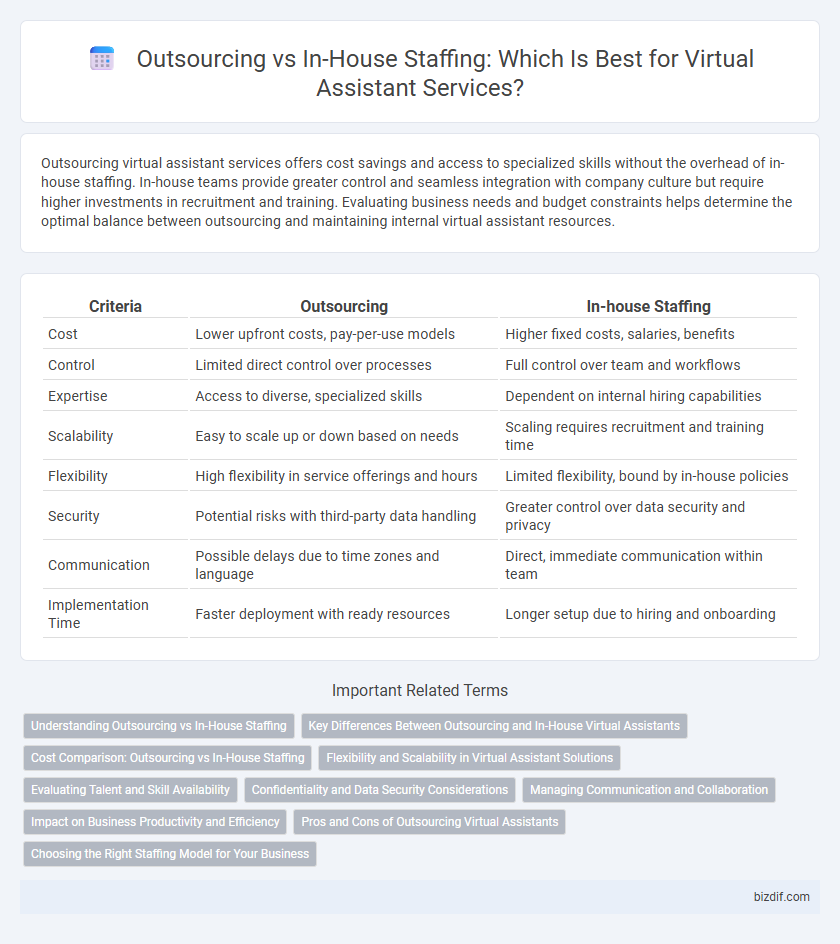Outsourcing virtual assistant services offers cost savings and access to specialized skills without the overhead of in-house staffing. In-house teams provide greater control and seamless integration with company culture but require higher investments in recruitment and training. Evaluating business needs and budget constraints helps determine the optimal balance between outsourcing and maintaining internal virtual assistant resources.
Table of Comparison
| Criteria | Outsourcing | In-house Staffing |
|---|---|---|
| Cost | Lower upfront costs, pay-per-use models | Higher fixed costs, salaries, benefits |
| Control | Limited direct control over processes | Full control over team and workflows |
| Expertise | Access to diverse, specialized skills | Dependent on internal hiring capabilities |
| Scalability | Easy to scale up or down based on needs | Scaling requires recruitment and training time |
| Flexibility | High flexibility in service offerings and hours | Limited flexibility, bound by in-house policies |
| Security | Potential risks with third-party data handling | Greater control over data security and privacy |
| Communication | Possible delays due to time zones and language | Direct, immediate communication within team |
| Implementation Time | Faster deployment with ready resources | Longer setup due to hiring and onboarding |
Understanding Outsourcing vs In-House Staffing
Outsourcing virtual assistant services offers access to specialized skills and cost-effective solutions by leveraging global talent pools, whereas in-house staffing provides direct oversight and stronger team integration within the company culture. Businesses must evaluate factors such as control, scalability, training, and data security when choosing between outsourced virtual assistants and internal hires. Understanding the trade-offs between flexibility and management control is crucial for optimizing workforce efficiency and operational goals.
Key Differences Between Outsourcing and In-House Virtual Assistants
Outsourcing virtual assistants offers cost efficiency, scalability, and access to specialized skills, while in-house staffing provides greater control, direct communication, and alignment with company culture. Outsourced assistants often work remotely across time zones, which can affect real-time collaboration but ensures round-the-clock support. In-house virtual assistants require investment in recruitment and training but foster stronger integration with internal teams and proprietary processes.
Cost Comparison: Outsourcing vs In-House Staffing
Outsourcing virtual assistant services typically reduces operational costs by eliminating expenses related to recruitment, training, benefits, and office space, often achieving savings of up to 60% compared to in-house staffing. In-house staffing incurs fixed costs including salaries, taxes, employee benefits, and overhead, which can significantly increase total expenditure especially for small to medium-sized businesses. Flexible outsourcing contracts allow scalability and budget control, contrasting with the rigid financial commitments of maintaining full-time in-house staff.
Flexibility and Scalability in Virtual Assistant Solutions
Outsourcing virtual assistant services offers greater flexibility and scalability, allowing businesses to easily adjust workforce size based on fluctuating demands without long-term commitments. In-house staffing requires fixed resources and limits rapid scalability due to recruitment and training time constraints. Leveraging outsourced virtual assistants enables dynamic resource allocation, optimizing operational efficiency and cost-effectiveness during peak and off-peak periods.
Evaluating Talent and Skill Availability
Outsourcing virtual assistant services provides access to a global talent pool with diverse skills and specialized expertise often unavailable in-house. In-house staffing allows for direct control over training and alignment with company culture but may limit the range of available skills due to local labor market constraints. Evaluating talent availability requires assessing the depth of skills, flexibility, and scalability needed for specific virtual assistant tasks.
Confidentiality and Data Security Considerations
Outsourcing virtual assistant services poses unique confidentiality challenges, requiring stringent data protection agreements and compliance with international privacy laws such as GDPR and HIPAA. In-house staffing offers greater control over sensitive information through direct oversight, secure internal networks, and tailored access permissions to mitigate data breaches. Evaluating the trade-offs between outsourcing flexibility and the enhanced data security of in-house teams is critical for safeguarding proprietary business information.
Managing Communication and Collaboration
Outsourcing virtual assistant services often requires robust communication platforms and clear protocols to bridge time zones and cultural differences effectively. In-house staffing enables direct, real-time collaboration and immediate feedback within the company's existing communication infrastructure. Effective management of communication and collaboration hinges on selecting the right tools tailored to the team's structure and workflow, ensuring seamless task coordination and productivity.
Impact on Business Productivity and Efficiency
Outsourcing virtual assistant services often leads to enhanced business productivity by providing access to specialized skills and scalable support without the overhead costs of in-house staffing. In-house virtual assistants can offer deep organizational knowledge and immediate collaboration, potentially improving task accuracy and internal communication. Balancing outsourced flexibility with the tailored expertise of in-house staff determines overall operational efficiency and resource optimization.
Pros and Cons of Outsourcing Virtual Assistants
Outsourcing virtual assistants offers cost savings, access to a global talent pool, and scalability, making it ideal for businesses with fluctuating workloads or limited budgets. However, challenges can include potential communication barriers, less control over daily operations, and concerns about data security. Companies must weigh these factors against in-house staffing's consistency and direct oversight to determine the best fit for their operational needs.
Choosing the Right Staffing Model for Your Business
Selecting the optimal staffing model for virtual assistant services depends on factors such as budget, scalability, and control over workflow. Outsourcing offers cost efficiency and flexible resource management, especially for small to medium businesses, while in-house staffing provides direct oversight and alignment with company culture. Evaluating your business needs alongside these parameters ensures a strategic balance between operational efficiency and personalized service delivery.
Outsourcing vs In-house staffing Infographic

 bizdif.com
bizdif.com